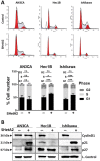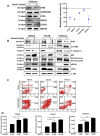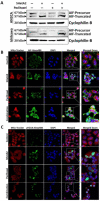Utility and Mechanism of SHetA2 and Paclitaxel for Treatment of Endometrial Cancer
- PMID: 34066052
- PMCID: PMC8150795
- DOI: 10.3390/cancers13102322
Utility and Mechanism of SHetA2 and Paclitaxel for Treatment of Endometrial Cancer
Abstract
Endometrial cancer patients with advanced disease or high recurrence risk are treated with chemotherapy. Our objective was to evaluate the utility and mechanism of a novel drug, SHetA2, alone and in combination with paclitaxel, in endometrial cancer. SHetA2 targets the HSPA chaperone proteins, Grp78, hsc70, and mortalin, which have high mutation rates in endometrial cancer. SHetA2 effects on cancerous phenotypes, mitochondria, metabolism, protein expression, mortalin/client protein complexes, and cell death were evaluated in AN3CA, Hec13b, and Ishikawa endometrial cancer cell lines, and on growth of Ishikawa xenografts. In all three cell lines, SHetA2 inhibited anchorage-independent growth, migration, invasion, and ATP production, and induced G1 cell cycle arrest, mitochondrial damage, and caspase- and apoptosis inducing factor (AIF)-mediated apoptosis. These effects were associated with altered levels of proteins involved in cell cycle regulation, mitochondrial function, protein synthesis, endoplasmic reticulum stress, and metabolism; disruption of mortalin complexes with mitochondrial and metabolism proteins; and inhibition of oxidative phosphorylation and glycolysis. SHetA2 and paclitaxel exhibited synergistic combination indices in all cell lines and exerted greater xenograft tumor growth inhibition than either drug alone. SHetA2 is active against endometrial cancer cell lines in culture and in vivo and acts synergistically with paclitaxel.
Keywords: SHetA2; apoptosis inducing factor; cell cycle arrest; endometrial cancer; glycolysis; metabolism; mitochondria; oxidative phosphorylation; paclitaxel; xenograft.
Conflict of interest statement
The authors declare no conflict of interest.
Figures






Similar articles
-
Manipulation of metabolic responses enhances SHetA2 efficacy without toxicity in cervical cancer cell lines and xenografts.Gynecol Oncol. 2024 Jan;180:44-54. doi: 10.1016/j.ygyno.2023.11.013. Epub 2023 Dec 5. Gynecol Oncol. 2024. PMID: 38052108 Free PMC article.
-
SHetA2 Attack on Mortalin and Colleagues in Cancer Therapy and Prevention.Front Cell Dev Biol. 2022 Feb 23;10:848682. doi: 10.3389/fcell.2022.848682. eCollection 2022. Front Cell Dev Biol. 2022. PMID: 35281109 Free PMC article. Review.
-
Distinct mechanism of cervical cancer cell death caused by the investigational new drug SHetA2.Front Oncol. 2022 Sep 20;12:958536. doi: 10.3389/fonc.2022.958536. eCollection 2022. Front Oncol. 2022. PMID: 36203464 Free PMC article.
-
Novel ovarian cancer maintenance therapy targeted at mortalin and mutant p53.Int J Cancer. 2020 Aug 15;147(4):1086-1097. doi: 10.1002/ijc.32830. Epub 2020 Jan 8. Int J Cancer. 2020. PMID: 31845320 Free PMC article.
-
Mitochondrial dysfunction in cancer.Prz Menopauzalny. 2014 May;13(2):136-44. doi: 10.5114/pm.2014.42717. Epub 2014 May 21. Prz Menopauzalny. 2014. PMID: 26327844 Free PMC article. Review.
Cited by
-
Manipulation of metabolic responses enhances SHetA2 efficacy without toxicity in cervical cancer cell lines and xenografts.Gynecol Oncol. 2024 Jan;180:44-54. doi: 10.1016/j.ygyno.2023.11.013. Epub 2023 Dec 5. Gynecol Oncol. 2024. PMID: 38052108 Free PMC article.
-
SHetA2 Attack on Mortalin and Colleagues in Cancer Therapy and Prevention.Front Cell Dev Biol. 2022 Feb 23;10:848682. doi: 10.3389/fcell.2022.848682. eCollection 2022. Front Cell Dev Biol. 2022. PMID: 35281109 Free PMC article. Review.
-
Prevention of hypertension-induced renal vascular dysfunction through a p66Shc-targeted mechanism.Am J Physiol Renal Physiol. 2025 May 1;328(5):F693-F701. doi: 10.1152/ajprenal.00331.2024. Epub 2025 Apr 2. Am J Physiol Renal Physiol. 2025. PMID: 40172516 Free PMC article.
-
Mitophagy in gynecological malignancies: roles, advances, and therapeutic potential.Cell Death Discov. 2024 Dec 5;10(1):488. doi: 10.1038/s41420-024-02259-x. Cell Death Discov. 2024. PMID: 39639053 Free PMC article. Review.
-
Targeting GRP75 with a Chlorpromazine Derivative Inhibits Endometrial Cancer Progression Through GRP75-IP3R-Ca2+-AMPK Axis.Adv Sci (Weinh). 2024 Apr;11(15):e2304203. doi: 10.1002/advs.202304203. Epub 2024 Feb 11. Adv Sci (Weinh). 2024. PMID: 38342610 Free PMC article.
References
-
- Cancer Facts and Figures. [(accessed on 1 April 2021)]; Available online: https://www.cancer.org/research/cancer-facts-statistics/all-cancer-facts....
-
- Aune D., Navarro Rosenblatt D.A., Chan D.S., Vingeliene S., Abar L., Vieira A.R., Greenwood D.C., Bandera E.V., Norat T. Anthropometric factors and endometrial cancer risk: A systematic review and dose-response meta-analysis of prospective studies. Ann. Oncol. 2015;26:1635–1648. doi: 10.1093/annonc/mdv142. - DOI - PubMed
-
- Arem H., Pfeiffer R.M., Moore S.C., Irwin M.L., LaMonte M.J., Sarto G.E., Nassir R., Luo J., Chlebowski R.T., Brinton L.A., et al. Post-diagnosis body mass index and mortality among women diagnosed with endometrial cancer: Results from the Women’s Health Initiative. PLoS ONE. 2017;12:e0171250. doi: 10.1371/journal.pone.0171250. - DOI - PMC - PubMed
LinkOut - more resources
Full Text Sources
Other Literature Sources
Miscellaneous

